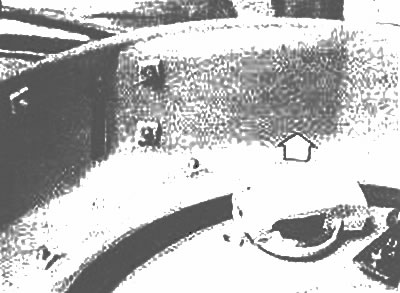General description
1. Intake flow temperature control system improves engine efficiency (efficiency) and reduces hydrocarbon emissions during warm-up by maintaining a controlled carburetor air temperature. This regulation of the inlet air temperature allows the carburetor to be slightly combined and the dampers to be calibrated.
2. The system uses a shock absorber assembly located in the air filter housing nozzle to control the ratio of cold to warm air going into the carburetor. This shock absorber is controlled by a vacuum diaphragm, which in turn is controlled by a temperature sensor in the air filter.
3. During the first kilometers of movement (depending on outside temperature) this system has the most effective engine control and emissions. When the engine is cold, the damper flap cuts off the air filter inlet tube, allowing only warm air from the exhaust manifold surroundings to flow. Gradually, as the engine warms up, the flap opens the pipe channel, increasing the supply of cold air. Once the engine reaches normal temperature, the flap opens fully, allowing only cold fresh air to enter.
4. Because of this, it is important to check this system periodically to prevent lean engine performance. If the air filter flapper is in the closed position at high temperatures, then the engine will run poorly, lose speed and increase emissions until it warms up. A valve sticking in position at high temperature will cause the engine to run under a constant flow of hot air to the carburetor.
Examination
5. For service and test procedures for this system, contact Section 1. If you encounter problems with the system while performing routine maintenance, refer to the relevant Sections of this manual.
6. If the shock absorber inlet does not seal air from the nozzle when the engine is cold, then disconnect the vacuum hose at the diaphragm and place your thumb on the end of the hose, check the vacuum. If there is vacuum progression to the diaphragm, then check that the shock absorber inlet and connection are not frozen or clogged within the air filter nozzle. If a vacuum pump is available, disconnect the hose and point it at the engine to make sure the shock absorber is being actuated. Replace the vacuum diaphragm if applying vacuum does not open the valve and route the hose correctly.
7. If there was no vacuum, check for cracks in the hoses and check the reliability of their connection. If the hoses are intact and in good condition, then replace the temperature sensor inside the air filter housing.
Replacement Parts
Air Filter Vacuum Diaphragm
8. Disconnect the vacuum hose from the diaphragm.
9. Remove the mounting screw, disconnect the rod and rotate the diaphragm from the air filter housing.
10. To install it, insert the diaphragm into the housing, rotate it into place, attach the rod and install the mounting screw.
11. Connect the vacuum hose.
Air filter temperature sensor
12. Remove the air filter to gain access to its reverse side.
13. Mark an arrangement and disconnect vacuum hoses from the gauge.
14. Carefully note the position of the sensor as it must be installed in exactly the same position. Remove the sensor from the air filter (photo).

The temperature sensor vent can be removed (arrow) right after disconnecting the vacuum hoses under the air filter assembly
15. Install the new sensor in the same position as the old one and attach the vacuum hoses.
16. Install the air filter element and air filter top cover.
